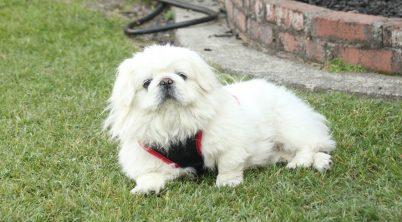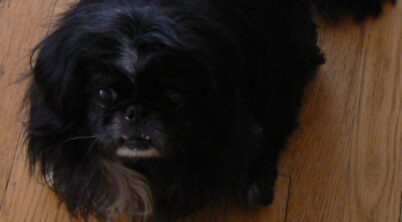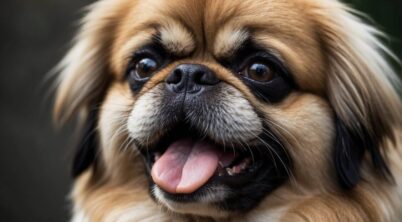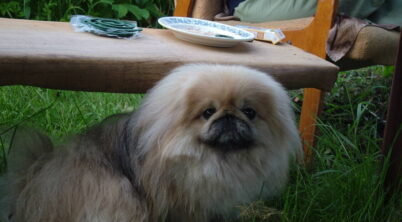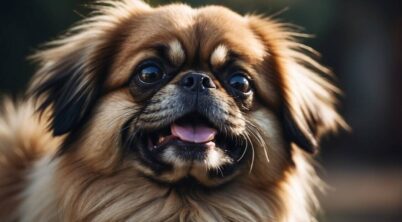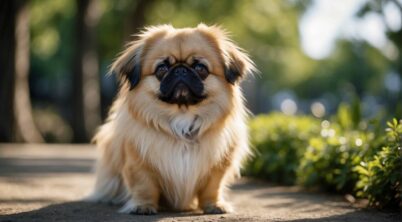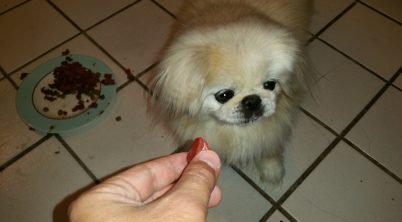The Pekingese, a breed with a storied history that originates in ancient China, was once revered as a companion to Chinese royalty. This historical context contributes to the breed’s demeanor; they are often seen as regal and self-important. Many refer to them affectionately as “lion dogs,” a nod to their distinct mane and bold character. Their intelligence is notable, yet it manifests differently than in some other breeds, emphasizing independent thinking over obedience.
Intelligence in the Pekingese is not marked by an eagerness to follow commands or a predisposition for tasks that some working breeds demonstrate. Instead, these small dogs exhibit their smarts through a strong sense of self and an independent nature. When assessing their intelligence, it’s important to consider that they may require more repetitions to learn new commands, typically around 80 to 100, placing them in the lower tier for obedience intelligence according to some dog intelligence rankings.
Despite not being top performers in traditional obedience-based measures of canine intelligence, Pekingese have exhibited the ability to learn and remember a range of words and commands, comparable to the linguistic comprehension of an average dog. Their affection and loyalty towards their owners make them cherished house pets, and while they may not be predisposed to excel in obedience trials, their intelligence is underscored by their capacity for complex social interactions and emotional depth.
Table of Contents
Is Pekingese Smart?
When assessing the intelligence of the Pekingese, it’s important to consider various aspects of their mental capabilities. They rank 73rd out of 138 recognized breeds in terms of obedience and working intelligence. This ranking suggests that, while not the most trainable, they do possess notable aptitude.
Regarding obedience, a Pekingese typically learns new commands after 80 to 100 repetitions, which places them in the Lowest Degree of Working/Obedience Intelligence Dogs category. They may also learn and respond to approximately 165 words and signals. Comparatively, some of the more intelligent dog breeds can master up to 250 words.
Nevertheless, the Pekingese breed demonstrates considerable adaptive intelligence. They are known to:
- Effectively communicate with their owners through various signals.
- Have the ability to count up to the number five.
- Trick other dogs and people during play to gain rewards or advantages.
It’s worth noting that the Pekingese was originally bred to be a companion animal for Chinese royalty. This heritage may contribute to their loyal and affectionate nature towards their family members. While they may not excel in obedience training, they are highly capable of forming strong bonds and interacting socially, indicating a different facet of canine intelligence.
Training a Pekingese requires patience due to their independent nature. However, with appropriate methods, they are certainly capable of learning. Socialization is recommended to ensure they are comfortable with a variety of people and situations.
Historical Significance and Origin
The Pekingese, with its longstanding association with Chinese royalty, is a breed that has captivated people since ancient times. In historical context, these dogs are known for their deep roots in Chinese culture and their connection with lion dogs, a term reflecting their resemblance to the Chinese guardian lions. The origin of the Pekingese is interwoven with legends, often linked to Buddha, who is said to have had a hand in their creation, endowing them with the spirit of a lion in a small animal’s body.
During the Second Opium War in 1860, significant events further shaped the narrative of the Pekingese. Amidst the chaos of conflict, British and French troops breached the walls of the Yuanmingyuan, the Gardens of Perfect Brightness. It was here they discovered the breed, which until then was exclusive to Chinese Imperial circles. Five Pekingese dogs were subsequently taken and gifted to Queen Victoria, introducing the breed to Europeans and increasing its notoriety.
In these early encounters with Westerners, the Pekingese’s distinguished air and idiosyncratic features were noted, earmarking it as an emblem of Eastern sophistication and mystique. The breed has since become a symbol of China’s rich historical tapestry and confirms the Pekingese’s status as an aristocratic and cherished companion of the past Chinese dynasties.
Breed Characteristics
The Pekingese is a toy dog breed notable for its distinctive physical and personality traits. With a weight typically between 7 to 14 pounds and a height of about 6 to 9 inches at the shoulder, they exhibit a compact, stocky stature. This breed is characterized by its brachycephalic nature, with a flat face and short snout, which are defining aspects of their appearance.
In terms of coat, the Pekingese boasts a luxurious double coat that comes in a variety of colors such as black, cream, red, white, gray, tan, and sable. Their coat, often resembling a “lion’s mane,” requires regular grooming to maintain its condition and to manage shedding.
- Size: Small; 6-9 inches at the shoulder
- Weight: 7-14 pounds
- Appearance: Lion-like mane, compact body
- Coat Colors: Black, Cream, Red, White, Gray, Tan, Sable
- Coat Type: Double coated
- Shedding: Moderate to heavy; requires regular grooming
- Face: Brachycephalic with a flat face and short snout
Owners should be aware that the breed’s brachycephalic traits can lead to certain health considerations. Their flattened faces can cause breathing challenges and care should be taken, especially in hot or humid weather. The Pekingese’s independent nature can sometimes be mistaken as a lack of intelligence, but they are quite capable of learning and responding to training; this just requires patience and a creative approach due to their independent streak.
Temperament and Personality
The Pekingese breed showcases a complex personality marked by a confident and regal demeanor. These dogs possess an innate charm coupled with a mixture of affectionate loyalty and independent spirit.
Behavioral Traits
Independent and Confident: Pekingese dogs are known for their self-assured and independent nature. They often exude confidence in their daily activities, approaching life with a dignified poise reminiscent of their royal heritage.
- Smart and Stubborn: As intelligent dogs, they can be responsive to training, but their smartness comes with a streak of stubbornness. Pekingese may require patient and consistent training methods.
- Loyal Companions: Their loyalty is intense, often forming a deep bond with a single person.
Socialization and Family Integration
Social Development: Proper socialization from a young age is crucial for the Pekingese. They tend to be reserved and can display a dignified distance in social settings. Early exposure to different people and pets can foster a more sociable temperament.
- Family Dynamics:
- Affectionate with Family: With family, they are loving and affectionate, making them excellent lapdogs.
- Regal Yet Playful: Although they carry a regal air, Pekingese can reveal a playful side within their trusted circle.
- Adaptation to Family Life:
- Great for Companionship: Pekingese dogs are adept at integrating into family life, providing companionship and enjoyment as a central figure in the home.
- Alertness: They tend to be alert watchdogs, often vocal and protective of their family despite their small size.
Training and Intelligence
Pekingese dogs exhibit a unique blend of intelligence characterized by both their astuteness and independent nature. They are not the easiest to train due to their strong-willed temperament, but with the right approach, they can learn and perform various commands and tricks.
Cognitive Abilities
The Pekingese, an ancient Chinese lapdog, demonstrates a distinct intelligence. Ranked 73rd out of 138 breeds, they possess a loyal demeanor and affectionate relationship with their owners that showcase their understanding and responsiveness. Although not at the top tier of working or obedience intelligence, Pekingese still exhibit smart behaviors suitable for watchdog roles due to their alert and vigilant nature. It’s important to recognize their capability to pick up on cues and perform tasks given patience and time.
Training Techniques and Challenges
Training a Pekingese can be a delicate balance because they are known to be stubborn and opinionated. Effective techniques include:
- Positive reinforcement: This should be the cornerstone of any training regimen. Rewarding desirable behavior encourages the Pekingese to repeat those actions.
- Consistency: Regular, consistent training sessions help the Pekingese understand what is expected of them.
- Patience: As they may require 80 to 100 repetitions to learn a new command, patience is paramount.
Challenges arise from their stubbornness and strong will. They may resist repetitive tasks or try to assert their dominance. To mitigate this, training should start early and incorporate a variety of activities to keep them engaged and less likely to become bored or uncooperative.
Health and Care Considerations
Health Overview:
Pekingese, generally having a lifespan of 12-14 years, may confront certain breed-specific health challenges. They necessitate vigilant care from their owners to maintain optimal well-being.
Diet and Obesity:
Due to their size, they require a well-balanced diet to prevent obesity—a condition that can exacerbate health issues. It’s important to monitor their food intake and provide food appropriate for their life stage.
Brachycephalic Concerns:
Being a brachycephalic breed, Pekingese have distinctive flat faces. This trait can lead to breathing difficulties, snoring, and snuffing. It is crucial for owners to be aware of respiratory complications and avoid excessive heat or stress.
Exercise Needs: The exercise regimen for Pekingese should be moderate to align with their calm disposition. Excessive exercise can strain their respiratory system, so regular, short walks and indoor play are beneficial.
Common Health Problems:
| Health Problems | Description | Consideration |
|---|---|---|
| Patellar Luxation | Dislocation of the kneecap, common in small breeds. | Regular veterinarian checkups recommended. |
| Eye Conditions | Due to large eyes, they may require daily cleaning to prevent issues. | Gentle cleaning with soft, damp cloth. |
Owners should conduct regular health checks, especially focusing on their eyes, and consult a veterinarian for any abnormalities. Patellar luxation, another concern for small breeds like the Pekingese, demands attention for signs of limping or discomfort. Early detection and management are key for a healthy Pekingese.

